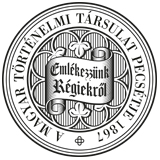Századok – 1992
Tanulmányok - Szakály Ferenc: A magyar nemesség a török hódoltságban V–VI/562
630 szakály ferenc 375 Heves megye műemlékei. I. Szerk: Dercsényi Dezső. Bp. 1978. (Magyarország műemléki topográfiája K) 458. és 466. 376 Karácsonyi ].: Szt. Ferencz-rend i.m. II. 67. 377 I.m. II. 68. vö. Rupp Jakab: Magyarország helyrajzi története, 16 tekintettel az egyházi intézményekre vagyis nevezetesb városok, helységek s azokban létezett egyházi intézetek, püspökmegyék szerint. II. Bp. 1876. 68.; a helység sorsáról: Soós l: i.m. 519. 378 Rupp J.: i.m. II. 67-69. és 71-72. 379 Szakáfy F.: Gyöngyösi ispotály-per i.m. 6. ш Gyöngyös, 1683. febr. 18. Fassiólevél. Németh G.: i.m. 76-77. 381 Németh G.: i.m. passim. 382 Rupp J: i.m. II. 67. 383 Darvas Jánosné Ráday Dona és a többi nagyrédei birtokos 1671. dec. 21-én megintette Almásy András gyöngyösi plébánost — nyilván, mert б gondozta a nagyrédei egyházat is —, hogy a szóban forgó szóló kilencedét és tizedét, ami mindig nekik járt, „az mint kádgyárul le szüret [sic!]" szolgáltassa ki. Bemásolva: Fülek, 1672. jún. 23. HmL, HKSz vm. közgy. jkv. IV. 139.; Almásy válasza: Gyöngyös, 1672. jan. 4. Uo. IV. 140. 384 Géczy Elek gyöngyösi superior tiltakozása: Fülek, 1673. márc. 2. Uo. IV. 215. 385 Kristó Gy. (szerk.) Szeged i.m. I. 732. HUNGARIAN NOBLES ON OCCUPIED TERRITORIES UNDER OTTOMAN RULE by Szakáfy Ferenc (Summary) The Article deals with the fate of Hungarian Nobility in the occupied territories from the occupation of Centra] Hungary in the mid-16th century to the expulsion of the Turks in the 1860s. Nearly all the privileged groups and layers of society (i.e. the nobility, the clergy and the citizens of the free royal boroughs) fled from the Turks. There remained still a few families from the ranks of the lesser nobility and there were quite a number of villages populated by noblemen with one hide of land each. However, they did not make up a characteristic social group in themselves. The Turks considered and taxed them as raajas the same as the peasants of their neighbourhood and they themselves seemed to be willmg to assimilate to the peasant community. The so-called Fifteen Years' War (1593-1606) brought significant changes in the number, social prestige and attitude of the noblemen living in occupied territories. There came a rapid increase m their number mainly in the region between the Danube and the Tisza rivers, as well as east of the Tisza, primarily in the economically strongest country towns, but the tendency could be observed nearly everywhere in the occupied territories. At the hight of this process the number of the noble families can be put to about one thousand. The most populous settlement of the nobility with more than one hundred families was Gyöngyös at the foot of the Mátra. The primary cause of their growth was the awakening to consciousness of the nobility (the nobilis,, the curialis and the predialis) as well as the massive rise of peasants by buying nobility. From the 1630s the members of the so far hiding old nolibity started to tum up and asked the bodies created for the administrative and legal representation of their interests (the so-called émigré counties of the nobility, the universitas nobiliorum) to have their noble birth and possessory rights acknowledged. This happened very liberally, mainly in the form of a testimony. The serfs who wished to become nobles both on the occupied territories and anywhere else had to buy their own and then plot's freedom first from the landlord. Then the royal chancellary usually gave the armalis, i.e. the letter patent of nobility for a consideration without further ado often though the instrumentality of the landlord himself. This patent did not involve any grant of land. The new nobleman became a member of the territorially competent county when his patent was read and approved of at the general assembly of the county. The gradually strengthening system of Estates in Hungary to gain ground after the long-drawn Ottoman occupation needed a local representation based on the old and new nobility under Ottoman rule. So the counties outside this area recognized the new members of the nobility as .jurors" or „ma-
